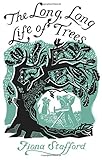| The Long, Long, Life of Trees by Fiona Stafford. For many, the oak is considered to be the king of trees, living for hundreds of years and housing a seeming universe of insects, birds, lichens, fungi, and mammals within a single tree:
"If anyone in England were asked to name the national tree, the answer would undoubtedly be the oak, though, oddly enough, this would also be true for people in Bulgaria, Croatia, Cyprus, Estonia, France, Germany, Latvia, Lithuania, Moldova, Poland, Romania, Serbia and the United States of America. Poland's founding myth is rooted in the giant oak on a hill, where a great eagle nested, inspiring Prince Lech to build his own nest -- or rather kingdom -- there, while his brothers, Czech and Rus, set off to establish their realms in the south and east. The most famous trees in modern Poland are the three veteran oaks named after these legendary brothers, which grow in the park at Rogalin, near Poznan, though Czech is now beginning to show his age. In Germany, oak trees were also a symbol of national strength, planted in war cemeteries to form the groves of heroes and commandeered by Bismarck asan emblem of unity. The oak appeals to separatists, too: the flag of the Basque Country depicts a shield ringed with a wreath of acorns and oak leaves. Everyone, it seems, wants to claim this tree astheir own.
"Sturdy, stalwart and stubborn, the oak has always been admired for its staying power. As early as the first century BC, the Roman poet Virgil singled out the oak for its enduring strength, praising the depth of its roots and its consequent ability to withstand even the severest onslaughts from the weather: 'Hence no winter storms, no blasts or rains uproot it; unmoved it abides, and many generations, many ages of men it outlives, letting them roll by while it endures.' Virgil's patron, Augustus Caesar, chose to wear the Civic Crown, the oak-leaf wreath that signified Rome's highest honour, when being immortalised in marble. In Ancient Greece, too, the oak was the tree of Zeus, most powerful of all the gods, whose commands were interpreted through the rustle of the oracular oak leaves at Dodona; and in Norse mythology, the oak was known as the tree of Thor, the thunder god.
"The strength of the oak is immediately evident. Whether you come across a single tree standing straight by the gate of an ordinary field or a whole company of oaks, dotted across a vast expanse of grassy parkland, the sheer physical power of the tree is unmistakable. No other tree is so self-possessed, so evidently at one with the world. Unlike the beech, horse chestnut or sycamore, whose branches reach up towards the sky, the solid, craggy trunk of a mature oak spreads out, as if with open arms, to create a vast hemisphere of thick, clotted leaves. The tip of a single twiglet might sprout four of five of these lovely, irregularly rounded leaves, and as each twig sends out any number of twiglets, a whole tree might be covered in as many as 250,000 leaves. As the temperatures rise in August, oaks put on an extra layer of foliage to make up for the mayhem caused by early summer moth larvae.
"The copious canopy of the oak attracts colonies of insects, birds and small animals. Tree creepers, nightingales, thrushes and wrens |

The Long, Long Life of Trees
Author: Fiona Stafford
Publisher: Yale University Press
Copyright 2016 by Fiona Stafford
|

No comments:
Post a Comment